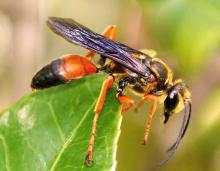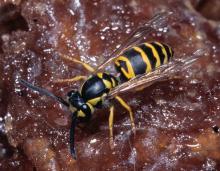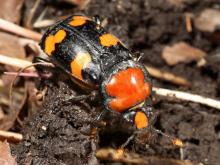Land Invertebrates
Media

Species Types
Scientific Name
More than 700 species in North America
Description
Ants are everywhere! They outnumber us a million to one. These colonial insects are familiar to everyone on Earth. Their lives are endlessly fascinating.
Media

Species Types
Scientific Name
About 60 species in North America north of Mexico
Description
The nymphs of spittlebugs and froghoppers are famous for hiding in small foamy masses of fluid. The “spit” conceals them as they suck juices from plant stems. The adults resemble leafhoppers.
Media
Species Types
Scientific Name
Sphecius speciosus
Description
The eastern cicada-killer wasp might be the scariest-looking wasp in our state. But it is not aggressive to people and is virtually harmless, unless handled roughly. Like other ground-nesting wasps, nests can be recognized by the mound of earth excavated by the female.
Media

Species Types
Scientific Name
Sphex ichneumoneus
Description
A large solitary wasp, the great golden digger wasp occurs throughout Missouri. The abdomen is orange in front and black at the end. The head and thorax have golden hairs. Like all solitary wasps, this species is not aggressive.
Media

Species Types
Scientific Name
Ammophila spp.
Description
There are more than 60 species of ammophila wasps in North America. They tend to be black, with orange on the abdomen. They are but one genus in the thread-waisted wasp family.
Media

Species Types
Scientific Name
About 300 species in North America north of Mexico
Description
People notice spider wasps when they notice a female lugging a captured spider to its doom. In most cases, she will drag the spider into a burrow, lay an egg on the spider, and then hunt for more spiders!
Media

Species Types
Scientific Name
Vespula spp.
Description
Yellowjackets are bee-sized social wasps that build paper nests, usually underground. Their defensive stinging can make them a major pest when they nest near people.
Media

Species Types
Scientific Name
Three genera: Sceliphron, Trypoxylon, and Chalybion
Description
Mud daubers are among the most familiar solitary wasps. They belong to a number of related groups, but we call them all "mud daubers" because they all build their nests out of mud. One way to tell the different mud daubers apart is by the distinctive architecture they use.
Media

Species Types
Scientific Name
Nearly 500 species in North America north of Mexico
Description
Velvet ants are not true ants. True ants are social insects, while velvet ants are a group of solitary wasps. Female velvet ants are wingless throughout their lives; males are winged.
Media

Species Types
Scientific Name
Nicrophorus americanus
Description
The American burying beetle is endangered statewide and threatened nationally. Restoration efforts are under way. This brightly patterned beetle specializes in cleaning carrion from the landscape, burying dead mice, birds, and other creatures.
See Also



Media

Species Types
Scientific Name
Cisseps fulvicollis
Description
The yellow-collared scape moth is more often “orange-collared.” And whether you think it looks more like a firefly or a wasp, it’s still a moth!
Media

Species Types
Scientific Name
Nearly 150 species in North America north of Mexico
Description
Slim, delicate plume moths are instantly recognizable by their T-shaped silhouette, long legs, and muted shades of tan and brown. It can be hard to separate the various species.
Media

Species Types
Scientific Name
Pyrrharctia isabella
Description
Not many people know the adult Isabella tiger moth when they see one, but we’re all acquainted with its caterpillar, the woolly worm, or woolly bear.
About Land Invertebrates in Missouri
Invertebrates are animals without backbones, including earthworms, slugs, snails, and arthropods. Arthropods—invertebrates with “jointed legs” — are a group of invertebrates that includes crayfish, shrimp, millipedes, centipedes, mites, spiders, and insects. There may be as many as 10 million species of insects alive on earth today, and they probably constitute more than 90 percent all animal species.





















